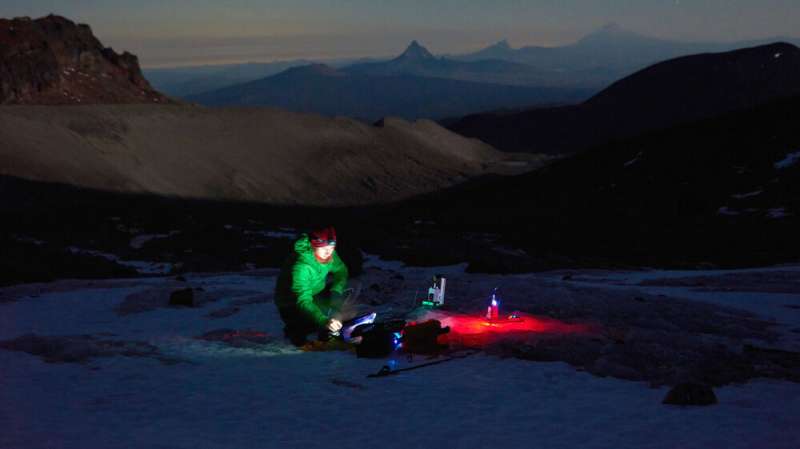Studying glaciers has never been easier than it is today, as the University of Oregon (UO) unveils a new tool for this purpose that fits in a backpack and can be carried by a single team up even steep slopes.

Glaciers around the world act as essential sources of fresh water for whole ecosystems and communities. They create incredible — and unique — landscapes. In the US state of Oregon, glaciers also act as a buffer against late-summer droughts, and release water even after the annual snowpack has completely melted. This is essential for maintaining the health of species such as salmon and trout.
That being said, glaciers are rapidly melting, both in Oregon and the rest of the globe, due to climate change. Our main approach to monitoring this melting has been through the use of satellite data of larger glaciers like Greenland and Antarctica. Although this can be very useful for large-scale monitoring, getting all the tiny details still requires sending people into the field on work-intensive and quite frigid expeditions.
Researchers at the University of Oregon are working to make those expeditions shorter and easier, however, by developing a portable tool for the measurement of glacier ice that can function in remote wilderness areas.
Out and about
“Studying how these glaciers respond to climate change is important for informing streamflow management both now and in the future,” said Johnny Ryan, a geographer at the UO who is using the new instrument in his research and a co-author of the paper describing it. “Many of the processes that we observe on Oregon glaciers also occur on the Greenland and Antarctic ice sheets. Oregon’s glaciers provide a great testing ground for new instrumentation and hypotheses.”
The device uses laser beams to measure the composition of glacial ice, recording data that can help determine how fast this ice is melting. It is designed to be easily portable by a single team and function in remote areas, such as Oregon’s Cascade Mountains, for as long as possible. Its main device, which produces the laser beam, fits into a hard-shell plastic briefcase. All other necessary gear, such as batteries and cables, fit in a few backpacks.
Its design is, in large measure, a direct consequence of the state where it was developed. Oregon’s glaciers sit high atop steep mountain slopes. They are located in designated wilderness areas that motorized vehicles are not allowed to enter. This severely limits how much heavy equipment or supplies (including energy sources) researchers can bring along on observation trips.
The new device works by recording the way a beam of laser light scatters back after contact with glacial ice. The higher the content of air bubbles inside the ice, the more scattered this beam will come out. By measuring how long it takes for photons in the laser beam to reach a detector positioned a few meters away from the light source, the team can then estimate the composition of the ice. This can be used to estimate how much sunlight the glacier absorbs and how much it reflects — and this, in turn, is a reliable indicator of how fast it is melting.
In order to test the device, the team first used it on samples in the lab and later tested it around town, just to make sure everything worked as intended.
“With field research, it has to work,” said Markus Allgaier, a postdoctoral researcher at UO and lead author of the paper. “You may not get another chance to come back and try again.”
After this initial stage, they took the device to the mountain glaciers; they chose Crook Glacier on Broken Top. The timing of their trip had to be carefully selected — late enough in the summer that the snows melted off the glacier to expose bare ice, but before any fresh snow started falling. They set up their device during the day, but waited until sunset to run the test, as ambient light can interfere with the readings. A second trip was made to North Sister’s Collier Glacier, where tests were run using the same approach.
Both tests were successful and served “as a demonstration of the technique”, the team explains. They add that certain improvements can be made to the device to increase the resolution of the data it retrieves or shorten measurement time, but these improvements have to be weighed against the increases in cost of the device they would incur.
Beyond direct measurement, the device allows researchers to better understand how particular glaciers interact with laser light. Data retrieved from this ground-based device can thus be used to ensure that satellite measurements of glaciers are accurate. By giving scientists a reliable tool through which to correct inaccuracies in satellite data, this device can help further improve our current monitoring of glacier dynamics, and our wider understanding of the climate mechanisms that influence them.
“There are some uncertainties about how much the laser penetrates in snow and ice,” Ryan said. “We can use our ground-based instrument to measure the penetration depth of green laser in snow and ice and see how it varies across space and time.”
“We’re hoping to take the instrument to Alaska and use what we’ve learned to do ground-truthing of satellite data”,” Allgaier adds.
The paper “Direct measurement of optical properties of glacier ice using a photon-counting diffuse LiDAR” has been published in the Journal of Glaciology.


